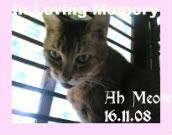Virus attack
.
.
.
.
.
by COLD SORE. This is my 3rd relapse of the virus (twice in Australia) and my 1st time getting here at home.
The First
The first time I spotted a red blister at the corner of my lips is during my honeymoon in 2001 at Sydney. I didn't think that this could be serious and dismissed it as another normal blister which will heal the next day. Of course it didn't go off the next day and it swelled causing more reddish water blisters and I can't even eat, talk or smile without having my lips to bleed.
I went to the local doctor and spent A$40 without any advice or diagnose from the stupid doc, I was merely given a prescription and was told to purchase my medicine at pharmacy down the street. WTF?? Spent A$40 and yet no medicine from the doc whatsoever?? Ripper!! If I know it, I would have gone straight to the pharmacy and save my A$40 which can be used to buy at least 20 pkts of Cadbury chocolates. Now I am more aware of the Cold Sore virus but only knew that stress and tiredness are the main causes of the outbreak (could be the stress over the wedding plan).
The Second
The moment I feel the tightening and burning sensation on my lips, I knew I am going to get the cold sore again. This time (as advised by my S'pore doc) I rushed to the nearest pharmacy at Margaret River, Perth for a cold sore cream, thank god the virus is quickly contained. The stupid pharmacist also told me to avoid nuts, eggs and chocolates, which is, of course, totally baseless. I went for 2nd consultation when I went back home and my doc told me that there’s no restriction on any food and cold sore usually takes a week to recover. Shitz!! She makes me missed the most important product in Aussie town - CHOCOLATES!!
I realise I still quite ignorant to the cause and symptoms of Cold Sore and decided to search further so that people like me can prevent the outbreak and save us from embarrassment and inconveniences due to the virus.
What Triggers Cold SoresCold sores are usually caused by the herpes simplex virus type 1 (HSV-1). The HSV-1 virus is part of the same virus family that causes chickenpox (varicella-zoster), shingles (herpes zoster), and genital herpes (herpes simplex virus type 2). Once the HSV-1 virus is in the body, it stays there in the nerves and never completely goes away.
HSV-1 infections are extremely common - it is estimated that 80% to 90% of the US population age 50 years and older has been infected with the virus. HSV-1 IS VERY CONTAGIOUS and can spread through physical contact, such as kissing.
The virus usually stays dormant in your body until something "triggers" it to the surface in the form of a cold sore. (which means once infected, the virus will always stay in your body FOR LIFE!!!)
Some of these triggers may include:
* Stress, tiredness, or being "run down" - (Main cause)
* A cold, fever, or the flu
* Exposure to the sun
* Cold weather – (yup, twice in Australia proven that)
* Hormonal changes, such as from menstruation or pregnancy
* Trauma, such as shaving cuts or dental work
A key to managing your cold sores is knowing what your triggers are. If you want to fight your cold sore virus you need to be prepared. Keep track of your trigger patterns so that you can take charge of your cold sores.
Cold Sore Stages
Understanding the stages, especially the tingling stage that may signal the onset of a cold sore, is important. If you are taking an antiviral medication like VALTREX, you should take it at the first sign of a cold sore.
Cold sore outbreaks can be different for each person, but in general, outbreaks last 7 to 10 days and occur 3 to 4 times a year. Cold sores also tend to follow these stages:
Stage 1 - The virus "wakes up" in your body, traveling through the nerve endings towards the lips.
Stage 2 - You may feel a tingling, itching, or burning sensation beneath the surface of the skin, usually around the mouth or base of the nose. This is the beginning of a cold sore, or the prodrome stage.
Stage 3 - Within a day or so, small red bumps appear in a group.
Stage 4 - These bumps begin to blister into a full-blown cold sore.
Stage 5 - After a few days, the blisters dry up and form a yellow crust.
Stage 6 - The crust eventually falls off, leaving a red tender area.
Stage 7 - The redness fades as your immune system sends the herpes virus back into hiding.
Stage 8 - Once a cold sore outbreak has run its course, the virus "sleeps," waiting for something to trigger it into action again.
When you have a cold sore DON'T:
* Don't kiss other people, even light pecks to parents, children, or friends. The herpes virus is easily spread this way. In fact, this is how many people got the infection in the first place.
* Don't touch your cold sore with your hands. If you do, be sure to wash with soap and water right away.
* Don't engage in oral sex. The herpes virus that causes cold sores is an increasingly common cause of new cases of genital herpes infections in the US.
* Don't wait until your next cold sore outbreak to ask your doctor about treatment.



:
testing
Post a Comment
Subscribe to Post Comments [Atom]
<< Home